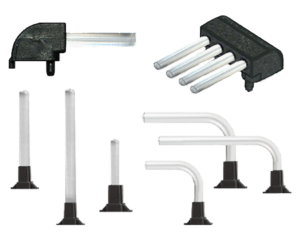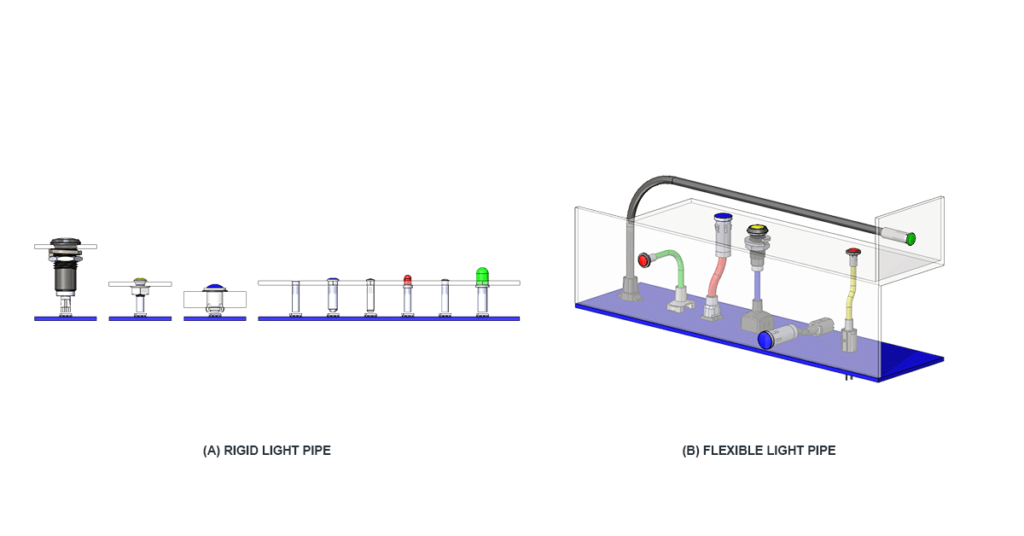A light pipe is a solid transparent plastic rod or an optical fiber used for transmitting light. The non-conductive light path requires no solder or crimped terminations and eliminates the potential of electrical shorts due to pinched wires; no solder or crimp terminations are needed. A light pipe offers several benefits, including clean status indication and simpler human factors engineering. Light pipes are critical components in many modern electronics applications.
The most common categories of LED light pipes are rigid pipes and flexible pipes. The two types offer you a distinct choice for your design. But which one to choose? Like many decisions in life, it depends on what you’re looking for. Here’s a quick rundown of the key facts to help you out.
Rigid Light Pipes

Figure 2: Rigid light pipes are available in numerous configurations, including models with integrated LEDs
A rigid light pipe is designed to carry light shorter distances in moderate to high vibration conditions and in damp or dusty environments. Rigid light pipes are available in many configurations including vertical, right angle and multi-levels and are designed for distances up to 3 inches. A rigid light pipe is constructed from polycarbonate, a material with several desirable properties. It is highly transparent; it has high impact resistance; it is durable and has high heat resistance, making it suitable for high-temperature environments. It is also non-flammable.
Rigid light pipes are available in numerous configurations (figure 2), including straight, right angle, single-unit, or multiple-unit, stacked or vertical arrangements Rigid light pipes with an IP67-rated heavy-duty threaded retention provide maximum protection against liquid and dust incursion. Complete solutions are available that include the light pipe, the LED, and a surface-mount adapter.
Overall, rigid light pipes are an economical way to move light from an LED to the indication area on the front panel when direct access is available.
Flexible Light Pipes
A flexible light pipe is preferred when light must be moved over longer distances or around obstacles between the LED and a front panel or other display location. A flexible light pipe assembly consists of an adapter, which provides less light bleed, and a flexible optical fiber with a lens cap. Flexible light pipes are immune to electromagnetic interference (EMI) and do not conduct or transfer electrostatic discharge (ESD) pulses.
Figure 3: A flexible light pipe system has several constituent parts
Flexible light pipes are more complex and cost more than rigid light pipes; they solve accessibility challenges for engineers by giving them the flexibility to bypass components on the printed circuit board (PCB) that prevent a straight-line access to the indication area on the front panel.
Figure 3 shows the various parts of a flexible light pipe design. The components consist of the LED at point A; a Zero Light Bleed ™ (ZLB) adapter that ensures no light bleeds into an adjacent pipe; a plastic optical fiber (POF); and a lens cap at point B that is bonded to the POF.
Flexible light pipes make it easy to add additional indicators or replace a damaged assembly because the lens cap at point B can be up to 330 feet from the LED light source at point A. The light pipe and lens need far less room near the panel face than the LED and its circuitry. If a human-factors engineer finds another indicator is necessary and space is an issue, a large redesign can be avoided by adding another indicator with a flexible ZLB routed from another LED that may be in a completely different location from the first LED. The coupling of design time and design space radically improve cost concerns in a variety of industries and applications. Five different colors of POF jackets improve installation and visual identification in the field by technicians, as well as clarify references in user manuals.
You make the call – guidelines on choosing the best type of light pipe
Rigid and flexible light pipes offer you two distinct options. Each one has advantages and disadvantages. Here are some guidelines to help you make the right choice.
Consider a rigid light pipe if these parameters apply to your project:
- Light only needs to travel a short distance
- Low cost is a top priority
- The printed circuit board is located close to the front panel with simple access available
Look towards using a flexible light pipe if:
- The light must travel a long distance
- The design of the equipment does not allow for a direct path from the LED to the display lens
- There is a possibility that additional indicators may need to be added later
- The human factors design is not yet finalized
- The LED output must travel through a high-EMI environment before reaching the lens cap.
Bivar engineers are always available to help you develop custom solutions to your most complex light pipe issues. Contact us!
FAQ
1. Durability Factors for Light Pipes: What would affect the durability of rigid and flexible light pipes?Environmental factors such as high heat, extreme cold, high humidity, along with mechanical factors such as excessive vibration and exceeding the minimum bend radius of a flexible light pipe may all affect the durability and function of light pipes.
2. LED Light Performance in Different Light Pipes: How do the brightness, intensity, and color fidelity of LED light transmitted through rigid light pipes compare to those transmitted through flexible ones?Using the same LED, both types would result in very similar profiles. Rigid light pipes are for shorter transmission lengths, typically under 75mm, while the flexible light pipes can have longer lengths, and can go around obstacles inside the enclosure.
3. Combining Rigid and Flexible Light Pipes: Is it possible to use rigid and flexible light pipes simultaneously within a single device, and if so, under what circumstances would this be beneficial or practical?Rigid light pipes require a direct path from the PCB-mounted LED out through the design’s panel. A flexible light pipe is typically used to go around structures and obstacles when there is not a direct path from the PCB out to the panel. Combining a rigid light pipe and a flexible light pipe into one solution is not recommended. Please contact our engineering team to help with this type of solution. We can provide an optimal solution based on your needs.
4. Operational Conditions for Light Pipes: What are the established temperature boundaries and conditions (in both warm and cold environments) under which rigid and flexible light pipes can function optimally?The conditions can be slightly different depending on the materials used. The typical range with products made with PA66 is -30°C to +70°C, and polycarbonate light pipes have a range between -40°C to +100°C. One of our latest products, UHF, is a flexible light pipe made with silicone material and it has a broader temperature range of -40°C to 200°C.
5. Maintenance Requirements for Light Pipes: Are there particular cleaning or upkeep protocols needed for both rigid and flexible light pipes to ensure their sustained performance over time?Keeping the output lens clean with a soft cloth sprayed with a mild cleaner will help with light intensity. The light pipes on the inside of the enclosure will stay as clean as the rest of the enclosure and this should be considered in enclosure design.
